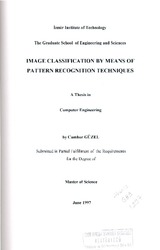Please use this identifier to cite or link to this item:
https://hdl.handle.net/11147/4058| Title: | Image Classifcation by Means of Pattern Recognition Techniques | Authors: | Güzel, Cumhur | Advisors: | Püskülcü, Halis | Publisher: | Izmir Institute of Technology | Abstract: | Image classification plays an important role in many computer vision tasks such as surface inspection, shape determination etc. Various 2-D image classification techniques are investigated, assessed and a computational method to classifY the 2-D X-ray images is developed and evaluated in this study. Various pattern recognition techniques are devised for the solution of the image classification. Those techniques may be divided into mainly two groups. First one, is mathematical and statistical model based, second one, is the artificial neural network based techniques. We have concentrated on artificial neural network techniques. In the experiments, both techniques were applied for the classification of the VUR (vesico ureteral reflux) images, in this study. However, according to the experiments performed on VUR case study, neural network technique was more successful than others, in terms of classifier. A hybrid method is proposed in this study, rather than pure artificial neural network solution. Representation of images is performed via transformation invariant mathematical structure called Fourier Descriptors and these structures are used as input to train the neural network for the classification part.The application is performed as follows: Feature extraction is performed first, then extracted features are used as pattern vectors for training the neural network. Representation of the shapes in X-ray images is performed by using Fourier Descriptors. Usage of Fourier descriptors as a method of representation of the shapes, provides the transformation invariant' (translation, rotation, scaling invariant structure) representation of X-ray images. These new vector representation is fed to the neural network. Backpropagation is used as a training algorithm. After training is finished, system is readyfor questioning. The minimum-mean-distance and nearest neighbor rules are also applied for the pattern vectors generated for the experiments. But the multilayer perceptron trained by backpropagation outperforms both of these statistical classifiers. | Description: | Thesis (Master)--Izmir Institute of Technology, Computer Engineering, Izmir, 1997 Includes bibliographical references (leaves: 83-88) Text in English; Abstract: Turkish and English vi, 114 leaves |
URI: | http://hdl.handle.net/11147/4058 |
| Appears in Collections: | Master Degree / Yüksek Lisans Tezleri |
Files in This Item:
| File | Description | Size | Format | |
|---|---|---|---|---|
| T000037.pdf | MasterThesis | 51.95 MB | Adobe PDF |  View/Open |
CORE Recommender
Page view(s)
334
checked on Mar 31, 2025
Download(s)
232
checked on Mar 31, 2025
Google ScholarTM
Check
Items in GCRIS Repository are protected by copyright, with all rights reserved, unless otherwise indicated.